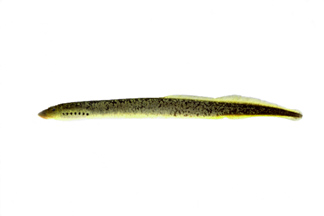The mountain brook lamprey is a nonparasitic species with an undivided dorsal fin and degenerate teeth in the buccal cavity. It has a naked eel-like body with externally obvious muscle segmentation and seven pairs of gill openings. The adults may be olivaceous, brown, or gray in color.
Size: total length 120-160 mm (4.7-6.3 in.) (adults); maximum total length reported at 200 mm (7.8 in.)(Trautman 1981)
Trunk myomeres: 53-62 (usually 55-58)
Dorsal fin: undivided
Teeth: less developed than in parasitic Ichthyomyzon; inner lateral teeth bicuspid; transverse lingual lamina bilobed and denticulate
Color: adults olivaceous, brown, or gray
Special Protection Status:
Rangewide: Ichthyomyzon greeleyi is listed as threatened in Kentucky but not listed in any other SE states [P. W. Shute, pers. comm., Leader, TVA Natural Heritage Project (February 27, 2001)].
In Park Status:
Ichthyomyzon greeleyi has no special status in the Park. Mountain brook lampreys are presumably rather sedentary, with poor dispersal capabilities. Once eliminated from an area (extirpated), human intervention may be necessary to restore the population. This is likely the case in Abrams Creek. All plants and animals are protected in National Parks and collection requires a permit that is usually granted only for scientific or educational purposes.
Rangewide: Ichthyomyzon greeleyi is listed as threatened in Kentucky but not listed in any other SE states [P. W. Shute, pers. comm., Leader, TVA Natural Heritage Project (February 27, 2001)].
In Park: Ichthyomyzon greeleyi has no special status in the Park. Mountain brook lampreys are presumably rather sedentary, with poor dispersal capabilities. Once eliminated from an area (extirpated), human intervention may be necessary to restore the population. This is likely the case in Abrams Creek. All plants and animals are protected in National Parks and collection requires a permit that is usually granted only for scientific or educational purposes.
Similar species. There are currently no other species of Ichthyomyzon known to occur in the Park. However, the parasitic Ichthyomyzon bdellium is similar to Ichthyomyzon greeleyi and the two often occur together. Ichthyomyzon bdellium likely occurs in lower Abrams Creek. Adult Ichthyomyzon bdellium have teeth much better developed than those of Ichthyomyzon greeleyi. In larval Ichthyomyzon bdellium the gut, with a spiral muscle pattern, is the prominent abdominal structure, while in Ichthyomyzon greeleyi larvae, the developing paired gonads occupy more space than the degenerating gut.
Ichthyomyzon greeleyi inhabits small upland rivers and creeks and has a mid-May to early June spawning period; death of adults occurs shortly following spawning. The larval life span is estimated to be 5-7 years for upland populations in western North Carolina. Metamorphosis to adults begins between early and mid-August, and continues for 100-140 days. Non-spawning adults are found in strong riffles of clean gravel and rubble. Nests have been found in slow to moderate riffles or just above swift riffles, with peak nest building and spawning occurring mid-afternoon in a temperature of 18.8 degrees C.
Upper Ohio River drainage of Pennsylvania and southern tributaries to the Ohio River south throughout the Tennessee River. It is abundant in Tennessee in small to medium upland streams but absent from Coastal Plains areas.
Ichthyomyzon greeleyi is fairly rare in the larger portions of Little River, but is fairly common in the Oconaluftee River from the lower portion of Raven Fork downstream. It was collected in Abrams Creek before the reclamation project on Abrams Creek in 1957 (Simbeck 1990).
Special Protection Status:
Rangewide: Ichthyomyzon greeleyi is listed as threatened in Kentucky but not listed in any other SE states [P. W. Shute, pers. comm., Leader, TVA Natural Heritage Project (February 27, 2001)].
In Park: Ichthyomyzon greeleyi has no special status in the Park. Mountain brook lampreys are presumably rather sedentary, with poor dispersal capabilities. Once eliminated from an area (extirpated), human intervention may be necessary to restore the population. This is likely the case in Abrams Creek. All plants and animals are protected in National Parks and collection requires a permit that is usually granted only for scientific or educational purposes.
References:
Etnier, David A. and Wayne C. Starnes. 1993. The Fishes of Tennessee. University of Tennessee Press. Knoxville, Tennessee.
Simbeck, Damien J. 1990. Distribution of the Fishes of the Great Smoky Mountains National Park. Master of Science Thesis, University of Tennessee.
Trautman, M.B. 1981. The fishes of Ohio. 2nd Ed., Ohio State Univ. Press, Columbus, 782p.
Animalia
Chordata
Cephalaspidomorphi
Petromyzontiformes
Petromyzontidae
Phenology
Hubbs and Trautman

